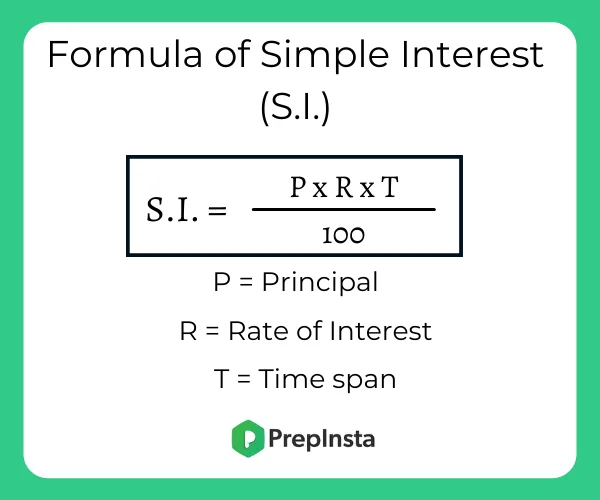Quants Menu
- HCF and LCM
- Number System
- Number Decimals & Fractions
- Surds and Indices
- Divisibility
- Ages
- LCM
- HCF
- Inverse
- Speed Time and Distance
- Work and Time
- Boats and Streams
- Pipes and Cisterns
- Averages
- Allegations and Mixtures
- Ratio and Proportions
- Simple & Compound Interest
- Simple Interest
- Compound Interest
- Percentages
- Profit & Loss
- Successive Discount 1
- Successive Discount 2
- AP GP HP
- Arithmetic Progressions
- Geometric Progressions
- Harmonic Progressions
- Probability
- Permutation & Combination
- Combination
- Circular Permutation
- Geometry
- Heights and Distances
- Perimeter Area and Volume
- Coordinate Geometry
- Venn Diagrams
- Set Theory
- Algebra
- Linear Equations
- Quadratic Equations
- Logarithms
- Clocks
- Calendars
- Clocks and Calendars
- Finding remainder of large powers
PREPINSTA PRIME
Formulas for Simple Interest And Compound Interest
Formulas To Find Averages In Aptitude
On this page we have discussed Simple Interest and Compound Interest formulas, definition with examples.
Interest formulas mainly refer to the formulas of simple and compound interests.

Definition of Simple Interest
- The interest calculated on the amount initially invested or loaned. It is a method for calculating the interest earned or paid on a certain balance in a specific period.
- Simple interest is a quick and easy method of calculating the interest on a sum of Amount. It is determined by multiplying the daily interest rate by the principal amount and the number of days .


Definition Of Compound Interest
- Compound interest is the addition of interest to the principal sum of a loan or deposit. Compound interest is calculated based on the principal, interest rate, and the time period involved.
- It is the addition of interest to the sum of Amount or Principal Amount i.e. interest on interest. It is the result of reinvesting interest.So that interest in the next period is then earned on the principal amount and previously accumulated interest.


Prime Course Trailer
Related Banners
Get PrepInsta Prime & get Access to all 200+ courses offered by PrepInsta in One Subscription
Formula for Compound Interest
- Interest Compounded Annually
- Amount = \mathbf{P\left ( 1+\frac{R}{100n} \right )^{nT}}
- Compound Interest = Total amount – Principal
- Rate of interest (R)(in %) = n[(\frac{A}{P})^{\frac{1}{nT}} – 1]
Interest Compounded Half-Yearly
- When interest is compounded Half yearly Then, we must consider n=2, Hence, Formula for Amount = \mathbf{P\left ( 1+\frac{R}{100\times 2} \right )^{2T}}
- Compound Interest = Total amount – Principal
- Rate of interest (R) (in %)= 2(P^{\frac{1}{2T}} – 1)
Interest Compounded Quarterly
- We have to consider n=4. So, Amount = \mathbf{P\left ( 1+\frac{R}{100\times 4} \right )^{4T}}
- Compound Interest = Total amount – Principal
- Rate of interest (R) (in %)= 4(P^{\frac{1}{4T}} – 1)
Interest is Compound Monthly
- When the interest is compounded montly then, n=12. So, formula for Amount = \mathbf{P\left ( 1+\frac{R}{100\times 12} \right )^{12T}}
Interest is Compounded Annually but Time is in Fraction, say 2(3/2) years
- When the Interest is Compounded Annually but Time is in Fraction. Then, the formula Amount = P (1+r/100)2 * (1+(3/2)r/100)\mathbf{(1+ \frac{r}{100})^{2}}\mathbf{(1+ \frac{\frac{3r}{2}}{100})}
CI when Rates are Different for Different Years
- When rates are different for different years . Then, Amount = P (1+ \frac{r_{1}}{100})(1+ \frac{r_{2}}{100})(1+ \frac{r_{3}}{100})
Formula for Simple Interest
- Simple Interest
SI = \mathbf{\frac{P * R * T}{100}}
Where,
P = money borrowed or lent out for a certain period
r = rate of interest
t = time period for which the amount is lent
Principal = \frac{100 × SI}{R × T }
Rate = \frac{100 × SI}{P × T }
Time = \frac{100 × SI}{R × P }
Total Amount of Money
- Amount = Principal + Interest
- A = P + I
Question 1 : Vanraj shah borrowed a sum of Rs. 10,000 at 8% per annum compounded annually. If the amount is to be paid in three equal installments, the annual installment will be
Solution : Let each installment be x,
10000=\frac{x}{(1+\frac{8}{100})} + \frac{x}{(1+\frac{8}{100})}^{2}+ \frac{x}{(1+\frac{8}{100})}^{3}
10000=x{\frac{25}{27} + (\frac{25}{27}) ^{2}+ (\frac{25}{27}) ^{3}}
=x*\frac{25}{27}(1 + \frac{25}{27} + \frac{625}{729})
=\frac{25x}{27} *(\frac{2029}{729})
x =3880.335
Question 2 : A financier lends money at simple interest, but he includes the interest every six months for calculating the principal. If he is changing an interest of 20%, the effective rate of interest becomes?
Solution : Let the sum be Rs. 100. Then,
S.I. for first 6 months = \frac{100 * 20 * \frac{1}{2})}{100} = Rs.10
Next 6 months 20% of 110
S.I. for last 6 months =Rs.\frac{110 * 20 * \frac{1}{2})}{100} = Rs.11
So, amount at the end of 1 year = Rs. (100 + 10 + 11) = Rs. 121 R
= (121 – 100) = 21%
Question 3 : Raghav singh purchases a coat for Rs.2400 cash or for Rs.1000 cash down payments and two monthly installments of Rs.800 each. Find the rate of interest.
Solution : Amount as a principal for 2 month = 2400 – 1000 = 1400
At the rate of r% per annum after 2 months,
Rs.1400 will amount to Rs 1400 + (\frac{1400*r*2}{100*12})
Total amount for 2 installments at the end of second month
Rs800+(800+(\frac{800*r*1}{100*12)}))
Then 1400 + \frac{2800*r}{1200}=1600+ \frac{800*r}{1200}
R=120%
Question 4: Mohsin khan invested Rs. 20,000 in a scheme at simple interest @ 15% per annum. After three years he withdrew the principal amount plus interest and invested the entire amount in another scheme for two years, which earned him compound interest @ 12% per annum. What would be the total interest earned by Mosses at the end of 5 years?
Solution: SI= 20,000*15*3/100=9000
Amount=20,000+9000=29,000
Now CI= 29,000*(1+12/100)^{2}
= 29,000 * 28/25 * 28/25 = 36,377.6
A-P=36, 377.6-29000=7377.6
After 5yrs 7377.6+9000=16,377.6
Question 5 : Bobby deol invested his money for a certain time. It amounts to Rs. 600 at 10% per annum. But when invested at 5% per annum, it amounts to Rs. 400. Find the time.
Solution : 600-P=P*10*\frac{t}{100} —>1
===>6000-10P=Pt
400-P=P*5*\frac{t}{100}—->2
===>8000-20P=Pt
Equate 1 and 2
6000-10P=8000-20P
==>P=200
Substitute P in 1 then
400=200*10*\frac{t}{100}
==>20yrs.
Also Check Out
Get over 200+ course One Subscription
Courses like AI/ML, Cloud Computing, Ethical Hacking, C, C++, Java, Python, DSA (All Languages), Competitive Coding (All Languages), TCS, Infosys, Wipro, Amazon, DBMS, SQL and others
- Averages – Questions | Formulas | How to Solve Quickly | Tricks & Shortcuts
- Allegations and Mixtures – Questions | Formulas | How to Solve Quickly | Tricks & Shortcuts
- Ratio and Proportions – Questions | Formulas | How to Solve Quickly | Tricks & Shortcuts
- Simple Interest – Questions | Formulas | How to Solve Quickly | Tricks & Shortcuts
- Compound Interest – Questions | Formulas | How to Solve Quickly | Tricks & Shortcuts
- Percentages – Questions | Formulas | How to Solve Quickly | Tricks & Shortcuts
- Profit & Loss – Questions | Formulas | How to Solve Quickly | Tricks & Shortcuts
Others
- Allegations and Mixtures –
Questions |
Formulas |
How to Solve Quickly |
Tricks & Shortcuts - Ratio and Proportions –
Questions |
Formulas |
How to Solve Quickly |
Tricks & Shortcuts - Averages –
Questions |
Formulas |
How to Solve Quickly |
Tricks & Shortcuts - Simple Interest –
Questions |
Formulas |
How to Solve Quickly |
Tricks & Shortcuts - Compound Interest –
Questions |
Formulas |
How to Solve Quickly |
Tricks & Shortcuts - Percentages –
Questions |
Formulas |
How to Solve Quickly |
Tricks & Shortcuts - Profit & Loss –
Questions |
Formulas |
How to Solve Quickly |
Tricks & Shortcuts
Others

 Apply For Jobs
Apply For Jobs Get Hiring Updates
Get Hiring Updates




I can not see simple and compound interest quiz . could you provide me !
Some of the special topics we are provided in the online courses,
so, go through the given link: http://www.prepinsta.com/online-classes